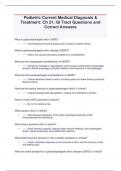Pediatric Current Medical Diagnosis &
Treatment: Ch 21: GI Tract Questions and
Correct Answers
What is gastroesophageal reflux (GER)?
✓ ~~~ Uncomplicated recurrent spitting and vomiting in healthy infants.
What is gastroesophageal reflux disease (GERD)?
✓ ~~~ Reflux that causes secondary symptoms or complications.
What are the esophageal manifestations of GERD?
✓ ~~~ Symptoms (heartburn, regurgitation) and mucosal complications (esophagitis,
stricture, Barrett esophagus) primarily related to acid exposure in the esophagus.
What are the extraesophageal manifestations of GERD?
✓ ~~~ Clinical disorders linked to reflux, including upper and lower airway symptoms,
dental erosions.
What are the typical features of gastroesophageal reflux in infants?
✓ ~~~ Frequent postprandial regurgitation, ranging from effortless to forceful.
When is infant GER expected to resolve?
✓ ~~~ By 12-18 months of life.
What causes reflux in infants?
✓ ~~~ Spontaneous relaxations of the lower esophageal sphincter (LES)
unaccompanied by swallowing.
What factors promote reflux in infants?
✓ ~~~ Small stomach capacity, frequent large-volume feedings, short esophageal
length, supine positioning, slow swallowing response.
What determines the severity of reflux-related symptoms in infants?
✓ ~~~ Infants' individual responses to the stimulus of reflux and the maturity of their
self-settling skills.
What are some symptoms of gastroesophageal reflux disease (GERD) in infants?
, ✓ ~~~ Failure to thrive, food refusal, pain behavior, GI bleeding, upper or lower
airway-associated respiratory symptoms, or Sandifer syndrome.
What are some symptoms of GERD in older children?
✓ ~~~ Regurgitation into the mouth, heartburn, and dysphagia.
What is a possible complication of GERD in older children?
✓ ~~~ Esophagitis.
What diagnostic procedure is required to confirm esophagitis?
✓ ~~~ Endoscopy with biopsy.
Which children are at increased risk of GERD and esophagitis?
✓ ~~~ Children with asthma, cystic fibrosis, developmental delay/spasticity, hiatal
hernia (HH), and repaired esophageal atresia—tracheoesophageal fistulas.
What are some extraesophageal manifestations of reflux disease?
✓ ~~~ Upper airway symptoms (hoarseness, sinusitis, laryngeal erythema, and
edema), apnea or apparent life-threatening events (ALTEs), lower airway symptoms
(asthma, recurrent pneumonia, recurrent cough), dental erosions, and Sandifer
syndrome.
What are some warning signs in infants with recurrent vomiting that warrant further
investigation?
✓ ~~~ Bile-stained emesis, GI bleeding, onset of vomiting after 6 months, failure to
thrive, diarrhea, fever, hepatosplenomegaly, abdominal tenderness or distension, or
neurologic changes.
What is an upper GI series used for?
✓ ~~~ To investigate anatomic etiologies of recurrent vomiting, not for diagnosing
GERD.
What is the purpose of acid-suppressant therapy in older children with heartburn or
frequent regurgitation?
✓ ~~~ Diagnostic and therapeutic
When should a child be referred to a pediatric gastroenterologist for evaluation of
GERD?
✓ ~~~ If symptoms require ongoing acid suppressant therapy or if symptoms fail to
improve with empiric therapy
What are some nonreflux diagnoses that can present with reflux-like symptoms?
, ✓ ~~~ Eosinophilic esophagitis (EoE)
What is the purpose of esophagoscopy and mucosal biopsies in evaluating GERD?
✓ ~~~ To evaluate for mucosal injury secondary to GERD or nonreflux diagnoses
including EoE
Is endoscopic evaluation necessary for all infants and children with suspected
GERD?
✓ ~~~ No
What are the indications for intraluminal esophageal pH monitoring?
✓ ~~~ To quantify reflux and evaluate for objective evidence of symptom associations
What is the difference between pH probe and pH impedance probe?
✓ ~~~ pH impedance probe also measures multiple intraluminal impedance
When may pH impedance studies have a higher diagnostic yield?
✓ ~~~ In evaluating for respiratory or atypical complications of reflux disease or
breakthrough reflux symptoms while on acid-suppressant therapy
At what age does reflux spontaneously resolve in 85% of affected infants?
✓ ~~~ 12 months
What factors coincide with the resolution of reflux in infants?
✓ ~~~ Assumption of erect posture and initiation of solid feedings
How can regurgitation volume be reduced in infants?
✓ ~~~ Offering small feedings at frequent intervals and thickening feedings with rice
cereal
Is there evidence to support empiric use of acid suppression in infants with
unexplained crying or fussy behavior?
✓ ~~~ No
What is GERD?
✓ ~~~ Gastroesophageal reflux disease, a condition where stomach acid flows back
into the esophagus.
Why may empiric acid suppression not be appropriate in neonates with suspected
GERD?
, ✓ ~~~ Because careful attention to potential factors leading to symptoms and/or
objective testing is needed.
What are the therapeutic options for treating suspected esophageal or
extraesophageal complications of acid reflux in older infants and children?
✓ ~~~ Histamine-2 (H2)-receptor antagonists or proton pump inhibitors (PPIs).
What has PPI therapy been shown to do in the treatment of GERD?
✓ ~~~ Significantly heal both esophageal mucosal injury and symptoms within 8-12
weeks.
What are potential risk factors associated with long-term PPI therapy?
✓ ~~~ Risk for infection (pneumonia, Clostridium difficile-associated diarrhea) and an
increased risk for osteoporosis in adults.
Are there standardized recommendations for prophylaxis or surveillance for
complications in pediatric patients on long-term PPI therapy?
✓ ~~~ No, but one should consider weaning or discontinuing treatment if it is no longer
required.
Is there sufficient evidence to support the routine use of prokinetic agents for
treatment of pediatric GERD?
✓ ~~~ No.
Is spontaneous resolution likely in older children with GERD and those with
underlying neurodevelopmental disorders?
✓ ~~~ Less likely.
How can episodic symptoms of GERD be controlled?
✓ ~~~ With intermittent use of acid blockers.
What may be required for those with persistent symptoms of GERD?
✓ ~~~ Chronic acid suppression.
What are some complications of reflux esophagitis or chronic GERD?
✓ ~~~ Feeding dysfunction, esophageal stricture, and anemia.
Is Barrett esophagus common in children?
✓ ~~~ No, it is very uncommon.
In which patients may Barrett esophagus occur?




